Saulieu to Saint-Léger-Vauban
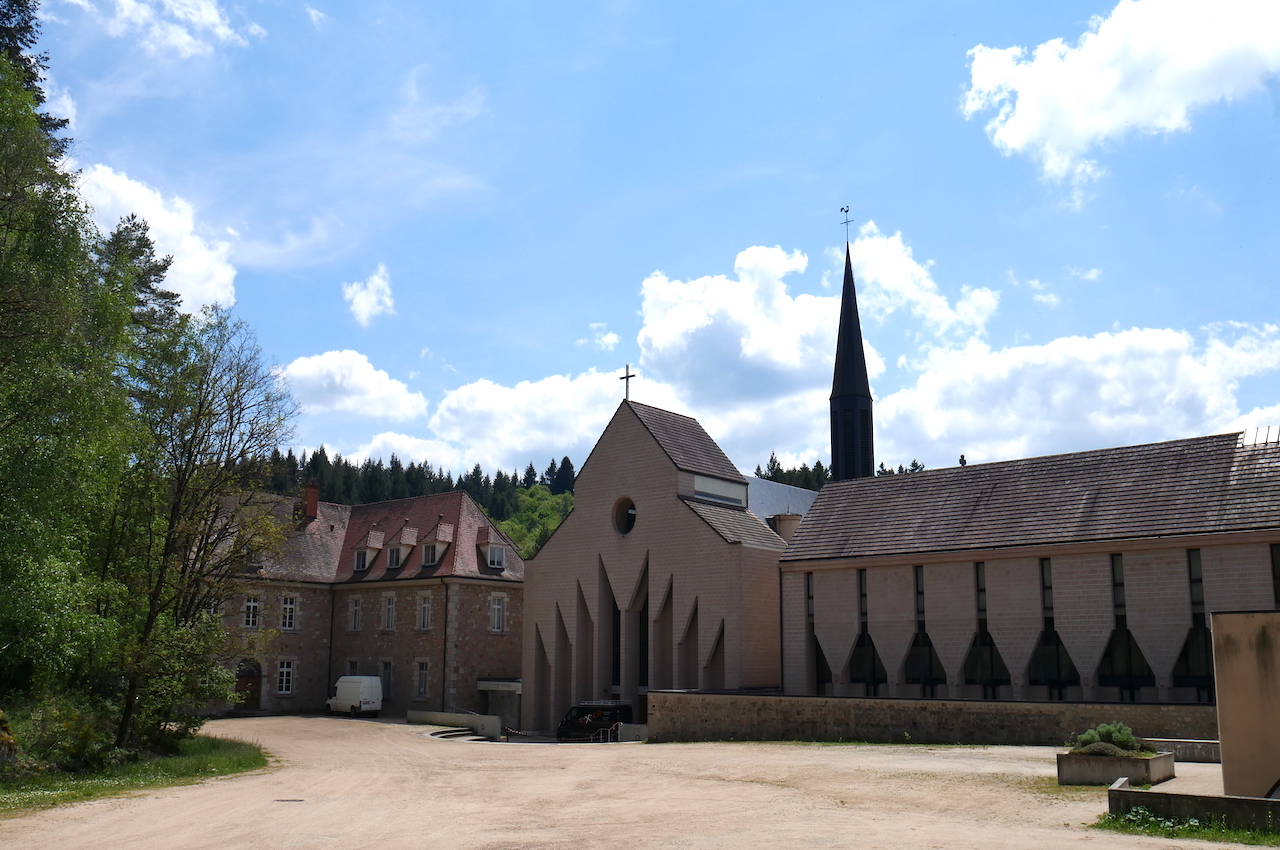
Bourgogne-Franche-Comté
1. Saulieu to Saint-Léger-Vauban
Medium
6h30
25,1km
+449m
-548m
Step
Embed this item to access it offline
You start your walk through the forest that alternates with Christmas tree nurseries. The pond of Saint-Agnan accompanies you for a few kilometres, then it is the proximity of the Trinquelin, the pond's outlet, which refreshes your walk in the forest, before your stop at the abbey Sainte-Marie de la Pierre-Qui-Vire. You will end this stage by discovering the church of Saint-Léger-Vauban where the famous military architect was baptized.
7 points of interest
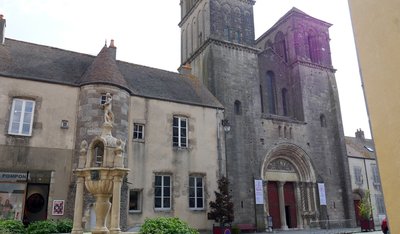
Façade de la basilique et de la fontaine Saint-Andoche à Saulieu - Amis saint Colomban TouristSaint-Andoche Church in Saulieu
The present basilica was built on the ruins of other earlier religious buildings located on the probable place of conservation of the relics of three Christian martyrs of the 2nd century, Andoche, Thyrse and Felix. The first basilica is a popular place of pilgrimage. In 447, the Bishop of Auxerre, Saint Germain, came to venerate the relics of the basilica on his way to Ravenna.
After the looting and destruction of the 9th and 10th centuries, the basilica was rebuilt during the Romanesque period and then destroyed during the Hundred Years War. It was partially rebuilt between the 15th and 18th centuries and the Romanesque capitals were preserved. In the 19th century, embellishment work was carried out on the present building.
A visit to the interior of the Basilica is a must to discover the beautiful Romanesque capitals, a prelude to your next visit to the Basilica of Vézelay.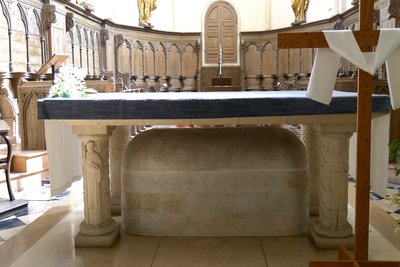
Sarcophage de saint Andoche sous l’autel de la basilique de Saulieu - Amis saint Colomban HistoricalSaint-Andoche in Saulieu
Andoche, is a priest, disciple of Polycarp of Smyrna, who came to evangelize Gaul with the deacon Thyrsus, Saint Benign (the apostle of Burgundy) and Saint Andean. Andoche, imprisoned in Saulieu, was to suffer martyrdom because of his faith, in 177 or 178.
Vue du lac Saint-Agnan depuis le barrage - Amis saint Colomban PanoramicLake Saint-Agnan
Lake St-Agnan is located on the border between the Yonne, the Côte d'or and the Nièvre. It is a quiet place where you can go pike-perch fishing. It extends over 150 ha in an unusual landscape of forests and large meadows. You are in the heart of the Morvan Regional Natural Park.
In the 12th century, this corner of the Morvan was only woods and deep forests. There was only one farm, La Grange de Saint-Agnan (Sancti Aniani Grangia), which the bishop of Autun, Étienne Ier de Baugé, gave in 1136 to Guillaume, second abbot of Fontenay. For a long time, the monks only took away butter, calves and pigs that they raised there, of which the place called the Porcherie (Pigsty) is a reminder.
The Saint-Agnan dam was inaugurated in 1969, it was built in the manner of the old pond levees, an earthen dyke lined with stones on the side of the lake. The maximum depth is 20 meters.
Église Saint-Agnan - Amis saint Colomban TouristSaint-Aignan Church
Near the lake of Saint-Agnan crossed by Le Cousin, stands this church which earned the town the other name of Saint-Agnan-la-chapelle.
In the 12th century, the bishop of Autun donated a farm to Guillaume, abbot of Fontenay, who recruited farmers to fertilize his land.
Little by little, these farmers settled and many hamlets still bear their names.
Until the end of the 18th century, Saint-Agnan was a place of pilgrimage on Easter Tuesday.
Recently restored, the church is entirely covered in slate. Only the sacristy to the left of the front door supports small tiles.
Four narrow buttresses support the building.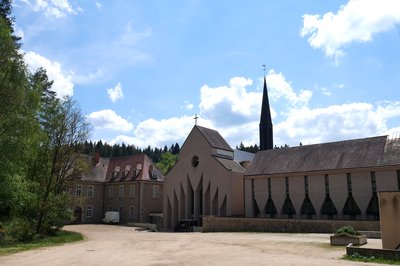
Abbaye Sainte-Marie de la Pierre qui Vire - Amis saint Colomban CulturalSainte-Marie de la Pierre Qui Vire Abbey
The name of the place, "the Pierre-qui-Vire", comes from a natural characteristic, namely a rock which, when placed on top of another, could be set in motion by simple human pressure. Today the rock is sealed and surmounted by a statue of the Virgin Mary.
Sainte-Marie-de-la-Pierre-qui-Vire Abbey is a Benedictine abbey founded in 1850 by Reverend Father Jean-Baptiste Muard. In 1859 it joined the Benedictine order.
The Third Republic's policy of suppressing congregations forced the community into exile in 1880 and again in 1904. It did not return to its monastery until after the First World War, in 1921, and has not left it since.
The fame of the abbey is partly due to the quality of the Zodiaque editions, founded in 1951 and specialized in Romanesque art, whose volumes were produced in the abbey's integrated printing shop until the early 2000s.
Further information: Pierre-qui-Vire community website
The Colombian community owes a lot to the work of Brother Adalbert de Vogüé of Saint Mary's Abbey. At the end of the 20th century, Brother Adalbert translated the Vita Columbani into French with annotations very useful for its understanding. He translated the Rule and Penitential written by Saint Columbani. This Benedictine scholar is in the tradition of the monks of the Congregations of Saint-Vanne - Saint-Hydulphe and Saint-Maur who did important research on monastic movements.
The Via Columbani owes much to him because he popularized the life of Saint Columbanan and his successors.
More information: Wikipedia
Statue de Vauban à Saint-Léger-Vauban - Amis saint Colomban HistoricalSébastien le Prestre de Vauban
In 1003 'Sanctus Loegarius de Morvenno' became Saint-Léger-de-Foucheret until 1867. The municipality owes its present name to the marshal de Vauban who was born here in 1633.
In the 10th century, it was part of the abbey of Vézelay, then of the abbey of Reigny in the 12th century. A Protestant preaching was established in the chapel of the castle which passed at that time to Tauvenay de Briquemaut, one of the main lieutenants of Coligny.
Vauban: his bronze statue on the square, as well as the plaque indicating the location of his birthplace attest to the impact he had on the commune. The museum on Vauban's achievements, created in 1980, and which became the theme house of the Morvan ecomuseum in 1996, is the crowning glory of the tribute paid to this great man.
Sébastien Le Prestre de Vauban : Wikipédia
Vauban Museum in Saint-Léger-Vauban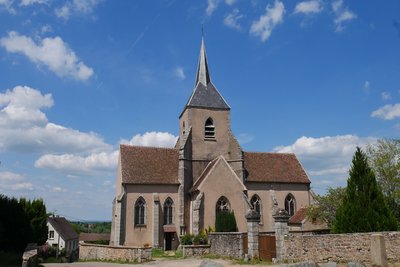
Église Saint-Léger - Amis saint Colomban TouristThe church of Saint-Léger-Vauban
St. Léger's Church was built in the 15th century, after the Hundred Years' War, on the site of an old 10th century church. It began with square pillars that solidly support the bell tower, followed by the nave and transept. The beginning of the Renaissance can be read in the Gothic vaults of the choir. The 17th century pews come from the basilica of Vézelay and decorate the back of this church. They were intended to seat the dignitaries facing the pulpit during preaching. Vauban was baptised in this church on 15 May 1633. Recent works: a mural by Jean Bouchery (1958), and sculptures and mosaic by Marc Hénard (1969-1979).
Description
Leave the church by bypassing the museum, rue Sallier, left, rue Monge, left, rue des Écoles, cross the rue de la Halle au Blé, left, rue du Collège, right, rue Vauban, left, bypass Place Charles-de-Gaulle, second street on the left, rue de l'étang, after the fire station, right, left, rue courteépée, route de Paris,
- Second street on the left, chemin d'Hébert Mourot, on the right towards the pond, first road on the left, on the right on a forest road then on the left on a road in the forest.
- On the right forest road, third crossroads on the left, cross the D 15b, continue into the forest.
- After 3,500 metres into the forest, cross the forest road to continue on the field path, tarred track on the right and then left along the pond,
- Les Augers, twice left on the asphalt road, D 225 on the right crossing the St-Agnan pond.
- Go around the church of Saint-Agnan to go along the pond, stay on your right so as not to leave the bank of the pond, take the road on the dam, at the end of the dam, first road on the left, follow the river Triquelin.
- Twice left to cross the river follow the left bank of the river until the next bridge to cross the river towards the Abbey Sainte-Marie de la Pierre Qui Vire
- Go around the abbey, cross the car park in the direction of the abbey cemetery, take the first path on the right and again on the right, walk along the forest road.
- Le Bouchot, at the crossroads turn right, rue de Trinquelin, chemin des Teurais, straight ahead, La Chaume
- Turn left on rue Marc Henard, first street on the right you arrive in front of the church of Saint-Léger-Vauban.
- Departure : Saint-Andoche Basilica, 4 Place Dr Roclore, 21 210 Saulieu
- Arrival : Saint-Léger Church, 16 rue de l’Église, 89 630 Saint-Léger-Vauban
- Towns crossed : Bourgogne-Franche-Comté
Altimetric profile
Report a problem or an error
If you have found an error on this page or if you have noticed any problems during your hike, please report them to us here:






